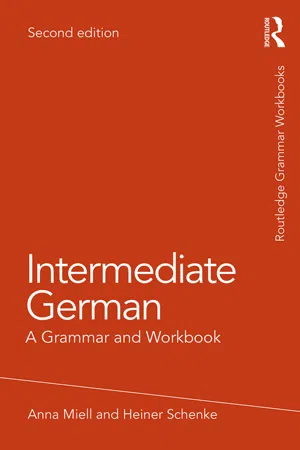
- 248 pages
- English
- ePUB (mobile friendly)
- Available on iOS & Android
eBook - ePub
About this book
Intermediate German: A Grammar and Workbook is designed for learners who have achieved basic proficiency and now wish to progress to more complex language. Each of the units combines concise grammar explanations with examples and exercises to help build confidence and fluency.
The new edition includes:
- up-to-date cultural aspects of German-speaking countries
- extended entries on adverbs and the imperative
- Did you know? sections with tips on learning strategies, and on contemporary usage
- more exercises to refine retention
Suitable for students learning with or without a teacher, Intermediate German forms a structured course of the essentials of German grammar and is suitable for students at intermediate level, corresponding to levels A2–B1+ on the CEFR or Intermediate High/Advanced Low with the ACTFL.
Frequently asked questions
Yes, you can cancel anytime from the Subscription tab in your account settings on the Perlego website. Your subscription will stay active until the end of your current billing period. Learn how to cancel your subscription.
At the moment all of our mobile-responsive ePub books are available to download via the app. Most of our PDFs are also available to download and we're working on making the final remaining ones downloadable now. Learn more here.
Perlego offers two plans: Essential and Complete
- Essential is ideal for learners and professionals who enjoy exploring a wide range of subjects. Access the Essential Library with 800,000+ trusted titles and best-sellers across business, personal growth, and the humanities. Includes unlimited reading time and Standard Read Aloud voice.
- Complete: Perfect for advanced learners and researchers needing full, unrestricted access. Unlock 1.4M+ books across hundreds of subjects, including academic and specialized titles. The Complete Plan also includes advanced features like Premium Read Aloud and Research Assistant.
We are an online textbook subscription service, where you can get access to an entire online library for less than the price of a single book per month. With over 1 million books across 1000+ topics, we’ve got you covered! Learn more here.
Look out for the read-aloud symbol on your next book to see if you can listen to it. The read-aloud tool reads text aloud for you, highlighting the text as it is being read. You can pause it, speed it up and slow it down. Learn more here.
Yes! You can use the Perlego app on both iOS or Android devices to read anytime, anywhere — even offline. Perfect for commutes or when you’re on the go.
Please note we cannot support devices running on iOS 13 and Android 7 or earlier. Learn more about using the app.
Please note we cannot support devices running on iOS 13 and Android 7 or earlier. Learn more about using the app.
Yes, you can access Intermediate German by Anna Miell,Heiner Schenke in PDF and/or ePUB format, as well as other popular books in Languages & Linguistics & German Language. We have over one million books available in our catalogue for you to explore.
Information
UNIT 1
Nouns and gender
What are nouns?
Nouns are words used to name living creatures, objects, abstract qualities or concepts:
Mann man | Pullover jumper |
Schönheit beauty | Entwicklung development |
German nouns – three genders
In German, nouns are classed as having one of three genders: masculine, feminine or neuter and are written with an initial capital letter. In dictionaries and vocabulary lists, the gender is usually indicated with der or m for masculine nouns, die or f for feminine nouns and das or nt for neuter nouns.
Working out the gender
Often there seems to be no obvious relationship between a noun and its gender in German: Pullover ‘jumper’ for instance is masculine, Jacke ‘jacket’ is feminine and Kleid ‘dress’ is neuter.
However, there are two main ways that can help you to work out the gender:
- • Certain endings indicate the gender.
- • Some groups of nouns, usually linked by meaning, tend to be masculine or feminine or neuter.
Endings indicating the gender
Masculine endings
The following endings usually indicate that the noun is masculine:
-ant | der Konsonant | consonant |
-ast | der Palast | palace |
-ich | der Teppich | carpet |
-ig | der Honig | honey |
-ling | der Schmetterling | butterfly |
-or | der Motor | motor, engine |
-us | der Professionalismus | professionalism |
Some exceptions are das Restaurant ‘restaurant’, die Last ‘burden’, and das Labor ‘laboratory’.
Feminine endings
The followin...
Table of contents
- Cover
- Half-Title
- Series
- Title
- Copyright
- Contents
- Preface
- 1 Nouns and gender
- 2 Plural of nouns
- 3 Articles, possessives and other determiners
- 4 Cases
- 5 Pronouns
- 6 Reflexive verbs
- 7 Modal verbs
- 8 Verbs with separable and inseparable prefixes
- 9 Verbs and prepositions
- 10 The imperative
- 11 The present tense
- 12 The present perfect tense
- 13 The simple past tense
- 14 The past perfect tense
- 15 The future tense
- 16 Adjectives
- 17 Adverbs
- 18 Prepositions
- 19 Forming questions
- 20 Conjunctions and clauses
- 21 Word order and sentence structure
- 22 Relative clauses
- 23 Negative constructions
- 24 The passive
- 25 Subjunctive forms
- 26 Indirect speech
- Key to exercises and checklists
- Glossary of grammatical terms
- List of common irregular verbs
- Index